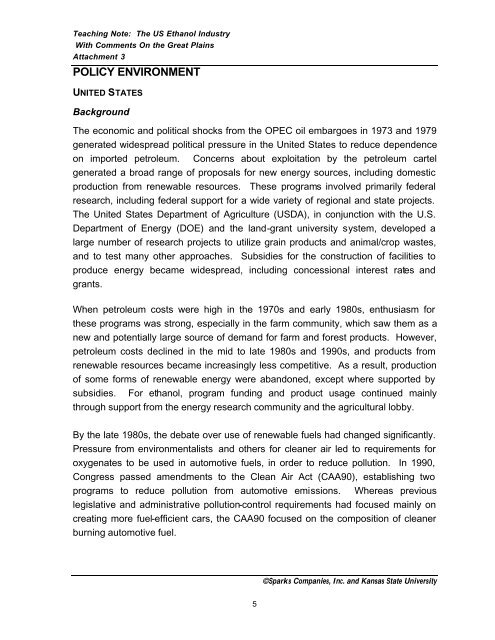teaching note: the us ethanol industry with comments ... - AgManager
teaching note: the us ethanol industry with comments ... - AgManager
teaching note: the us ethanol industry with comments ... - AgManager
You also want an ePaper? Increase the reach of your titles
YUMPU automatically turns print PDFs into web optimized ePapers that Google loves.
Teaching Note: The US Ethanol Ind<strong>us</strong>try<br />
With Comments On <strong>the</strong> Great Plains<br />
Attachment 3<br />
POLICY ENVIRONMENT<br />
UNITED STATES<br />
Background<br />
The economic and political shocks from <strong>the</strong> OPEC oil embargoes in 1973 and 1979<br />
generated widespread political pressure in <strong>the</strong> United States to reduce dependence<br />
on imported petroleum. Concerns about exploitation by <strong>the</strong> petroleum cartel<br />
generated a broad range of proposals for new energy sources, including domestic<br />
production from renewable resources. These programs involved primarily federal<br />
research, including federal support for a wide variety of regional and state projects.<br />
The United States Department of Agriculture (USDA), in conjunction <strong>with</strong> <strong>the</strong> U.S.<br />
Department of Energy (DOE) and <strong>the</strong> land-grant university system, developed a<br />
large number of research projects to utilize grain products and animal/crop wastes,<br />
and to test many o<strong>the</strong>r approaches. Subsidies for <strong>the</strong> construction of facilities to<br />
produce energy became widespread, including concessional interest rates and<br />
grants.<br />
When petroleum costs were high in <strong>the</strong> 1970s and early 1980s, enth<strong>us</strong>iasm for<br />
<strong>the</strong>se programs was strong, especially in <strong>the</strong> farm community, which saw <strong>the</strong>m as a<br />
new and potentially large source of demand for farm and forest products. However,<br />
petroleum costs declined in <strong>the</strong> mid to late 1980s and 1990s, and products from<br />
renewable resources became increasingly less competitive. As a result, production<br />
of some forms of renewable energy were abandoned, except where supported by<br />
subsidies. For <strong>ethanol</strong>, program funding and product <strong>us</strong>age continued mainly<br />
through support from <strong>the</strong> energy research community and <strong>the</strong> agricultural lobby.<br />
By <strong>the</strong> late 1980s, <strong>the</strong> debate over <strong>us</strong>e of renewable fuels had changed significantly.<br />
Pressure from environmentalists and o<strong>the</strong>rs for cleaner air led to requirements for<br />
oxygenates to be <strong>us</strong>ed in automotive fuels, in order to reduce pollution. In 1990,<br />
Congress passed amendments to <strong>the</strong> Clean Air Act (CAA90), establishing two<br />
programs to reduce pollution from automotive emissions. Whereas previo<strong>us</strong><br />
legislative and administrative pollution-control requirements had foc<strong>us</strong>ed mainly on<br />
creating more fuel-efficient cars, <strong>the</strong> CAA90 foc<strong>us</strong>ed on <strong>the</strong> composition of cleaner<br />
burning automotive fuel.<br />
©Sparks Companies, Inc. and Kansas State University<br />
5






![[U] User's Guide](https://img.yumpu.com/43415728/1/178x260/u-users-guide.jpg?quality=85)









![[P] Programming](https://img.yumpu.com/13808921/1/177x260/p-programming.jpg?quality=85)